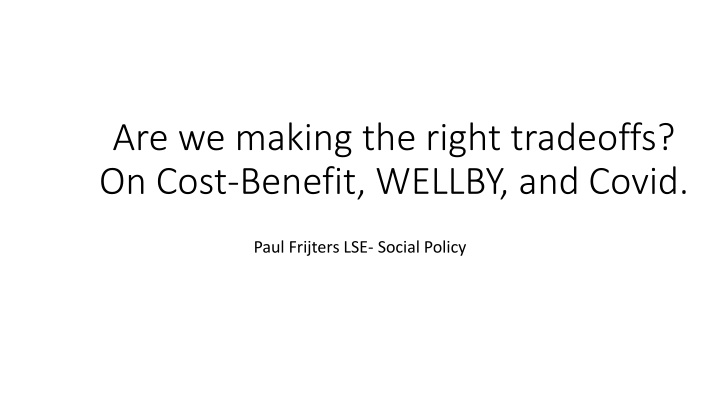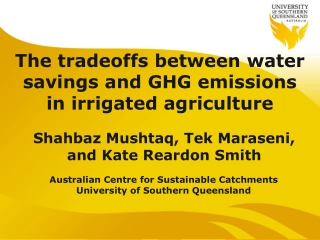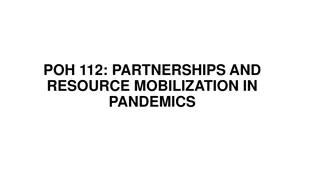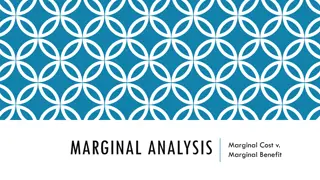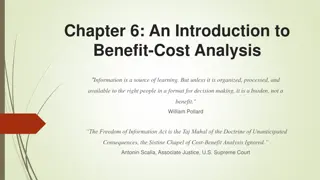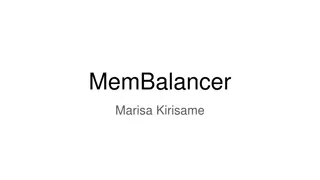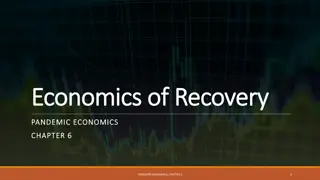Making the Right Tradeoffs on Cost-Benefit and Pandemics
How should humanity and governments judge reactions to a pandemic in terms of cost-benefit analysis? Explore historical pandemics, current COVID-19 data, and potential trade-offs between health interventions and economic impact. Learn from past pandemics like the Black Death and modern diseases such as Avian Flu and Swine Flu.
Download Presentation

Please find below an Image/Link to download the presentation.
The content on the website is provided AS IS for your information and personal use only. It may not be sold, licensed, or shared on other websites without obtaining consent from the author.If you encounter any issues during the download, it is possible that the publisher has removed the file from their server.
You are allowed to download the files provided on this website for personal or commercial use, subject to the condition that they are used lawfully. All files are the property of their respective owners.
The content on the website is provided AS IS for your information and personal use only. It may not be sold, licensed, or shared on other websites without obtaining consent from the author.
E N D
Presentation Transcript
Are we making the right tradeoffs? On Cost-Benefit, WELLBY, and Covid. Paul Frijters LSE- Social Policy
Content How to judge reactions of humanity and government to a pandemic? Basic trade-off numbers. How many happy years is the average covid death? How much government expenditure buys a happy year? How much unhappiness is created by unemployment or loneliness? Bringing it together. Deaths from do little versus costs of humanity s reaction . Covid Deaths from another month of lock downs versus damage of a month of lock downs
How to judge reactions to a pandemic? You want to know how bad the pandemic could be. What would happen if you treated it like just another disease? What would happen if you did specific things, like lock downs, track-and-trace, etc.? And you want to know how damaging reactions to the pandemic could be. The reaction in its totality includes the effect of fear and hysteria, with or without government intervention. For specific things, one has several counterfactuals in mind: from shrug shoulder to minimal community and government reaction . One chooses the actual counterfactual when presenting various scenarios via cost-benefit.
Pandemics that were Terrible The plague: the black death that killed half of Europe in the 14thcentury. Lock downs didn t help much as rats spread it.
Pandemics that werent UK mad cow diseases of the 1990s. In 1999, European Union scientists suggested up to 500,000 people could die from the UK mad cow disease. By October 2013, 177 deaths were recorded from the disease. Avian Flu of 2000s. In 2005, the UN s coordinator David Nabarro warned between 5 to 150 million people could die from avian flu. The World Health Organization s official estimates were 2 7.4 million. Only 455 people died of bird flu from 2003 2019. Swine flu 2009. The feared 1.3% fatality rate turned into an actual rate of 0.02%, In the UK, against the reasonable worst-case scenario of 65,000 deaths, there were only 457. Hat tip Ramesh Thakur: https://www.lowyinstitute.org/the-interpreter/flattening- economy-costs-lives-livelihoods-and-freedoms-too
Quick look at covid death tolls UK fatality estimates for Covid-19 were scaled down dramatically by Imperial College London within two weeks, from 510,000 to 20,000 and then 5,700 The WHO in February put out case based fatality estimates of 3-5%. This was then interpreted by many scientists to mean 3-5% of the world population, which would be over 200 million individuals. At present, the total recorded world death toll stands at around 320,000. That is the normal world death toll of two days. Those who die on average are old and have few remaining life years. The worst recorded death toll is New York (0.15%). A high toll for a Western country is 0.06%. Many countries have almost no deaths despite doing nothing much (Vietnam, the Indian countryside). So this is not the plague. Nor is it the Spanish Flu. In a do little scenario, the expected death toll, even in February 2020, among the moddelers was lower than 1% of the world population, and it was known that the victims had few years left. So one at the outset knew that any policy aimed at reducing covid deaths could maximally save 1% of lives and much less than 1% of life-years. How much what policy could save is far less certain.
Some sense of scale of effects. More than 100 million new unemployed in the West. 400 million worldwide. A GDP drop of 20% in the West and elsewhere. A feared famine and loss of innoculations in poor countries costing many millions. Civil wars brewing in Lebanon, India (with the Muslims blamed), and parts of Africa. Mass loneliness in lock down territories. 20,000 prevented IVF babies per month in the West. The same again elsewhere. Reduced usage of health services in the West due to fear. Disrupted education of several hundreds of millions of children.
Which of these are also in marginal effects (ie due to local policies)? And which are largely global? More than 100 million new unemployed in the West. Business bankruptcy. A GDP drop of 20% in the West. Sectoral collapse. A feared famine and loss of innoculations in poor countries costing many millions. Civil wars brewing in Lebanon, India (with the Muslims blamed), and parts of Africa. Mass loneliness in lock down territories. 20,000 prevented IVF babies per month in the West. The same again elsewhere. Reduced usage of health services in the West due to fear. Disrupted education of several hundreds of millions of children.
The example cost-benefit questions Costs versus benefits of all largescale reactions. Relatively easy to do. The economic collapse versus what was expected in January 2020. The social and emotional damage versus no change from January 2020. The death tolls of many events (like famines) versus no change from Jan 2020. Costs versus benefits of local government choices. Much harder and less certain. Additional economic costs of another month of lock downs. Emotional costs of track-and-trace versus do nothing . Such things need models and strong scenario assumptions. Some elements are easier to judge (like IVF babies) than others (like added unemployment).
What common metric to use in Cost-Benefit? The old common metric was economic surplus. Used by most governments and large organisations. A newer common metric is healthy years lived (the QALY approach). You can then more easily value health. The newest and my preferred metric is the WELLBY: happy years lived . You can then value anything that makes life enjoyable.
Basis of the QALY cost-benefit approach Essentially government then maximises SUM of the years lived by the population, weighted by the health quality of those years. Lots of subtleties (Who is the population? Discount rates? Etc.). Lets ignore those. Just think of undiscounted sum of QALYS of the current citizenry and their newborns. Health quality is essentially judged via the EQ5D , which are 5 subjective health questions.
EQ5D? This is primarily about physical health. The actual QALY level of patients and members of the population is then determined by their average answers to these questions. Many variations and subtleties.
The WELLBY The government then maximises the SUM of the years lived by the population, weighted by the wellbeing quality of those years. Wellbeing is measured by life satisfaction. In calculations you use predicted changes in life satisfaction, using causal estimates.
The UK life-satisfaction question (ONS4) Overall, how satisfied are you with your life nowadays? 0 is not at all and 10 is completely Essentially, a normal level for someone who is healthy is an 8. The level at which people are indifferent between living on or not at all is around 2. So a normal year of life is worth 6 WELLBY. So 1 QALY is worth 6 WELLBY is 1 regular year of happy life. The WELLBY captures (almost) everything that is important to people. The QALY does not and misses joy, status, and things that give fulfilment.
Basic tradeoffs Let s start with what a covid death is probably worth in terms of regular years of life and thus in terms of WELLBY and QALY.
Andrew Briggs on covid in the UK. Total deaths from ONS 3372 SMR=1 | qCM=100% LE QALE 76.45 66.41 66.51 56.46 56.69 47.07 46.98 38.05 37.49 29.38 28.36 21.61 19.86 14.76 12.30 8.79 6.42 4.52 3.03 2.06 11.04 8.08 SMR=2 | qCM = 90% LE 69.56 59.66 49.99 40.50 31.35 22.78 15.11 8.65 4.05 1.72 7.96 SMR=3 | qCM=80% LE 65.34 55.49 45.94 36.63 27.78 19.64 12.59 6.88 3.05 1.24 6.48 Age dist dQALY 27.65 25.54 23.29 20.68 17.51 14.21 10.75 7.04 3.95 1.91 6.15 QALE 55.16 46.24 37.87 29.90 22.33 15.71 10.12 5.48 2.48 0.95 5.20 dQALY 24.23 22.16 19.89 17.30 14.17 10.99 7.82 4.62 2.25 0.90 4.10 QALE 46.38 38.48 31.13 24.18 17.64 12.04 7.46 3.79 1.56 0.51 3.70 dQALY 21.07 19.10 16.96 14.51 11.61 8.72 5.94 3.27 1.44 0.49 2.97 0-9 0% 0% 0% 1% 2% 5% 11% 27% 39% 16% 10-19 20-29 30-39 40-49 50-59 60-69 70-79 80-90 90-100 weighted mean Bottom line: those who die with covid in the UK had 3-5 healthy years left to live on average. 3-5 QALY. 18-30 WELLBY Note, in Italy, the covid deaths had less lost QALY.
Second Crucial tradoff numbers How many lives are saved in the long-run by increased government health expenditure and by increases in GDP generally? You need this number to link recessions to lives, QALYs, and WELLBYs. There are two basic types of evidence. Fortunately they give almost the same answer.
From government expenses to health/life Evidence 1. We know from historical analyses and case-studies that: There is a strong long-run positive relation between many areas of government spending and health / life expectancy. Sewage / housing / GPs / clean water / toilets / good nutrition / innoculations / education all buy health. Part of the benefit is via herd effects : as some live better and longer, they are less sick and hence others run fewer health risks. This makes long-run group analysis important as short-run individual analyses don t pick this up. As a basic rule of thumb, an additional 10,000 in GDP PPP, starting from 1,000 per person, buys an additional 10 years of life, mainly via government expenses but also some private ones (good nutrition and sanitation in particular). Evidence 2. There are also official numbers that governments use as estimates for how much health and life their expenditures buy. Those numbers are very close to the historical relationship. On short-run fluctuations versus long-run ones (the Ruhm papers), see eg. https://socialsciences.nature.com/users/207399-joan-ballester/posts/43994-misconceptions-on-economic-growth- recessions-and-health
Government production costs of life? The UK government claims its health service produces 1 QALY for around 15,000 UK pounds (roughly 25,000 AUD). That is what operations, GP services, and other health expenses get a bang-for-buck. The number is not uncontested and might be twice as high. The government production cost of a WELLBY should also be set at 2,500 pounds per WELLBY (for ANY program) such that a normal year of life is generated at a cost of 15,000 pounds. So a regular year of life is produced by 25,000 AUD government expenditure. High-end estimates of some high-cost QALY and WELLBY purchases put the government expenditure cost at 50,000 AUD per regular year of life. On average in the world as a whole, these figures are 1/3 as high because the West is 3 times richer than the average in the world. Consumer willingness to pay for a QALY or WELLBY puts the value of a regular year of life around 100,000 AUD. So traditional economic analyses would convert 100,000 AUD of regular economic surplus into one regular year of life. More modern government CBA would take government health expenditure (and thus other expenditure as well) of 25,000 AUD to be worth one year of life. This is thus the ball park conversion number between economic activity and regular years of life: between 25k and 100k.
Implication 10 trillion AUD less in economic activity means around 4 trillion less in government expenditure, at least 1 trillion less in health expenses. That is worth at least 40 million regular life years, ie 40 million QALY and 240 million WELLBY. With rational government (other expenses have the same marginal benefit as health expenses), its 960 million WELLBY. The initial and still current estimate is that in 2020-2021 alone the world economy will shrink by 8 trillion USD. Discounted over the next 10 years, the total loss of all reactions is easily 50 trillion. 50 trillion AUS is thus at least 200 million regular life years, or between 40 and 67 million covid deaths . More realistically, it is 12 times higher than that for the world as a whole.
Third tradeoff number: costs of social isolation. The lock downs induce a loneliness/anxiety effect of around 0.5 WELLBY per individual. The best new evidence comes from State of life data in the UK that found that individuals who kept on working had no wellbeing loss, but the rest lost so much that the average loss was at least 0.4. Other studies put this number higher, hence the 0.5. Note that a 0.5 WELLBY effect means that per million inhabitants: You lose 500,000 WELLBY per year. That is about 82,500 regular years of life lost per year. That is equivalent to between 25,000 and 12,000 corona victim deaths per year. That is between 2,000 and 1,000 corona deaths per month. So for Australia, the loneliness effect alone of a month of lock downs is equivalent to between 20,000 and 45,000 corona virus deaths. Per 1 billion inhabitants ( the West ), this cost is equivalent to between 1 and 2 million coronavirus deaths. Per Month.
Fourth tradeoff number: cost of unemployment The unemployed lose at least 0.7 WELLBY per year of unemployment (Clark et al. 2019). The total effect on the whole community might be as high as 2 WELLBY. So 1 million unemployed for 1 year is equivalent to . You lose at least 700,000 WELLBY per year. That is about 116,700 regular years of life lost per year. That is equivalent to between 40,000 and 20,000 corona victim deaths per year. That is between 1700 and 3400 corona deaths per month. This effect can be proportionately attributed to lock downs or other measures to the degree they cause more or extended unemployment years. So 400 million additional unemployment years are equivalent to 8-16 million corona victim deaths. Minimally. More likely 3 times higher than that.
On unemployment: 400 mil 200 mil 200 mil Unem Unem March 2024 March 2022 March 2020 March 2023 March 2021 March 2020 March 2021 March 2022 More usual recession scenario reflecting actual loss of productive things to do and usual time till normality in a depression. Would mean additional roughly 800 million net unemployment years in the whole world. Optimistic quick recovery scenario, only an additional 200 million net unemployment years in the whole world.
Other tradeoff numbers There are many we can mention, including suicides, air pollution, and postponed hospital operations. Let me simply give just one example: IVF treatments, which were cancelled all over the world during lock downs.
Effect of loss of IVF babies The lock downs and suspensions of health services cost an additional 2,000 IVF babies per month in the UK and over 1,000 in Australia. They live on average 80 years. Their potential mothers and fathers also have a combined 80 years further to live, now without a child. Because they live 80 years and not 3-5, each baby is worth between 16 and 27 corona virus deaths. One should probably add around 10% to that via the loss to the parents. There is the question whether you want to count lost IVF babies at all, but since we regard the forced sterilisation of gypsies and others by the Nazis as genocide, we cannot pretend these lock down forced infertilities are not a form a damage that we should count as a loss. Maybe not 100%, but not 0% either. Note that one could have lock downs without stopping IVF treatment, but this has not happened widely and is difficult (fear makes this hard: unless you address the fear, IVF operations remain viewed as a liability).
Bringing it together: scenarios CBA analysis 1: All of humanity s reactions to covid versus shrug shoulders CBA analysis 2: An additional month of half lock downs in Australia versus shrug shoulders: regular economic and social life Note that if you believe there is a transition path between lock downs and regular life, then that does not alter the basic calculation: a month sooner one eases the lock down, a month sooner one starts the transition, so a month sooner one is back to normal.
All of humanitys reaction Potential benefits: lock downs saved between 0% and 1% of the world population, where the victims would live 3 to 5 regular years. Huge differences by country. Australia probably had a rho<1 anyway so never faced a serious threat. New York might have saved 0.2% of its population if they had dispersed that population immediately at the outset of the pandemic. Sweden is showing herd immunity can be achieved with total mortality rates of around 0.05%. The US (through incompetence rather than design) looks like getting the same outcome. 0.2% world mortality is 15 million covid deaths is around 60 million years of regular life (valuing them at 4 regular years of life each). So lets count 60 million years of regular life saved, ie 360 million WELLBY as the maximum benefits of humanity s reaction. Note this is 50 times the current world mortality, so very generous to the benefits of lock downs.
Costs of all the reactions Costs from economic collapse via government expenditure: 1.2 billion WELLBY at least, probably around 5 billion WELLBY. Cost via the mental anguish of unemployment: minimum 120 million WELLBY lost, probably more like 1.5 billion WELLBY lost. Cost via loneliness/stress if lock downs on average applied for 2 months to 4 billion people: 333 million WELLBY. In total, a minimum or 1.5 billion WELLBY, probably closer to 7 billion WELLBY, equivalent to 1.16 billion regular years, or 250 to 400 million corona virus deaths. So the costs outweigh the benefits by a minimum of a factor of 5 and more probably a factor of 100. On top of this come IVF baby costs, health costs due to reduced services, disruption of education, etc.
C-B on policies in Australia? Let us calculate something quite simple: Costs per month of no recovery and minimal lock downs , meaning no reduction in unemployment, recovery of GDP, end of only half the social isolation. One can see this as the costs of ongoing but not complete lock downs. One can compare that with what one believes the benefits would be.
Costs per month of no recovery Costs 1: loneliness/stress of 11 million Australians = 5.5/12 = 480,000 WELLBY Cost 2: continued unemployment of one million Australians = 0.7/12 = 58,000 WELLBY Cost 3: 1000 IVF babies prevented = 1,000*80*6= 480,000 WELLBY. Cost 4: reduced government expenses proportional to GDP loss = 6.7 billion = 63,000 QALY and 380,000 WELLBY per month at the minimum. So costs of postponing recovery and continuing 50% social isolation is at least 1,400,000 WELLBY per month, equivalent to 48,000 lives lost per month.
Benefits of lock downs. Benefits 100 prevented covid deaths per month = 100*30 WELLBY = 3000 WELLBY (thus assuming 5 good years per prevented death). Benefits 5,000 prevented deaths per month = 150,000 WELLBY. So costs versus benefits ranges from 10 to 500.
Conclusion The WELLBY cost-benefit approach allows one to add up apples and pears: loneliness and death, government expenditure and IVF babies. There is a huge literature to draw on as to the rough effects of circumstances on wellbeing. So it s a powerful tool for when there are many conflicting effects. Scenarios require assumptions. That is true for all decisions. Implied costs of the reactions to covid outweigh the benefits in any metric (healthy lives lived, happy lives lived) by at least a factor of 10. By any metric (lives/heath/WELLBY), delaying recovery in Australia with continued lock downs has far higher costs than benefits.
Suggested selected reading: Clark et al. (2019). Origins of Happiness. https://press.princeton.edu/books/hardcover/9780691177892/the- origins-of-happiness http://clubtroppo.com.au/2020/03/21/the-corona-dilemma Frijters, P., Krekel, C. (2020). Handbook for Wellbeing Policy. Oxford University Press forthcoming. Current version available on request. Frijters et al. The WELLBY, BPP. https://doi.org/10.1017/bpp.2019.39 Personal notes on the epidemiology: on request.
C-B on a month of lock downs in Australia? Here one must make a stand on how many corona virus deaths are saved by continued lock downs in Australia for another month versus a counterfactual in which the borders are fully opened and the virus can spread. This is an epidemiological questions on which honest opinions differ. Some say rho<1 anyway and so the answer would be a few hundred . Others say 0.5% of the population would eventually die so the answer would be 100,000 if we have full open borders . Yet others say something else would have few deaths as well (apps, targeted isolation, quarantines, etc.). Since the social and economic effects are large of most forms of inhibited movement and continued fear, the most relevant options are continued fear and thus continued isolation policies for at least half the population versus shrug shoulders .
Continued Lockdown equals Continued fear, half the population locked up, no economic recovery but a flatlined number of unemployment equal to 1 million above normal rates. Why flatlined economy? Tourism, students, property markets, hands-on services, international business, etc., continues to be very difficult and impaired. So no return of hospitality jobs, etc. GDP down 20% = 200 billion AUD per year = 80 billion less government expenditure per year = 6.7 billion less per month. Shrug shoulders equals Between a hundred and 5,000 additional covid deaths per month (so maximum costs smeared out over 20 months, which is the realistic arrival date of a vaccine). No social isolation costs. 1,000 IVF babies per month. Economic recovery starts so we get back to normal GDP and normal unemployment one month sooner than under continued lockdown. So the comparison here is between continued repression that involves ongoing but not increasing misery versus recovery to normality but with more covid death . You may want to think of other scenarios. The point here is illustration of how to do these calculations using a semi-realistic scenario.
Wellbeing Cost-Effectiveness Public cost the whole of government net costs Net Benefit benefit in terms of a WELLBY: an additional unit of Life Satisfaction for one person for one year
Cost-effectiveness of some low-hanging fruit Figure 1: Cost per WELLBY of interventions at work, in the environment, and government services.
